 A recent study by security vendor Prolexic Technologies has declared AOL to be king of the zombies, with their customer’s machines accounting for more infections than any other ISP.
A recent study by security vendor Prolexic Technologies has declared AOL to be king of the zombies, with their customer’s machines accounting for more infections than any other ISP.
A well as being a scary 1960s monster, zombies are also computers that have been infected with a daemon that puts it under the control of a malicious hacker – with the computer owner remaining blissfully unaware.
Zombie machines are often used by malicious hackers to launch Denial of Service (DoS) attacks, and Prolexic spent six months studying the data from real-world DoS attack attempts from hijacked machines.
Their findings put AOL right at the top of the Zombie league with 5.3 percent of all infections, followed by Deutsche Telekom in second place with 4.67 percent, and Wannadoo third with 3.27 percent.
Country by country, the good ol’ USA led the way, totting up a global market share of 18 percent of the total detected.
China lagged behind at 11.2 percent, with Germany on 9.6 percent,and the UK and France both with 5.1 percent.
If the figures are calculated on zombie numbers on a per capita basis, the most infected countries were – in descending order – Hong Kong, Germany, Malaysia, Hungary, and the U.K.
“It shouldn’t be a surprise to find that some of the most high profile Internet Service Providers are most susceptible to providing a safe haven for large numbers of Zombie PCs,” says Prolexic CTO Barrett Lyon. “It is these networks which are continually being exploited to support large scale DoS attacks.”
“Just because a home user subscribes to a reputable brand doesn’t mean they’re safe from the online criminal fraternity,” he says.
AOL was having none of it, saying that the suggestion that it is the most infected network on the Internet was “silly.”
 In full-on PR schmooze mode, AOL spokesman Andrew Weinstein declared the numbers to be “great news” for the company, pointing out that the number of Zombies on its network is actually low in relation to the total number of its members.
In full-on PR schmooze mode, AOL spokesman Andrew Weinstein declared the numbers to be “great news” for the company, pointing out that the number of Zombies on its network is actually low in relation to the total number of its members.
“We’re the largest ISP, so we’re going to have the largest of everything,” he whooped.
“Even though we’re several times larger than the next largest ISP, the rates of infection for those next-largest ISPs are basically the same.”
Although Weinstein acknowledged that over 10 percent of the Zombie attacks came from AOL, he was quick to point out that the company accounts for roughly 40 percent – or 21.7 million – of US Internet subscribers, thus making AOL customers three to four times safer than the average user of another ISP.
“I think this report is kind of silly; it’s like saying the US is the most dangerous country to drive in because we have the most cars,” he added.
Although Prolexic are yet to comment on AOL’s response, the company has emphasised that its Zombie data was culled from attempted real-world attacks, and not sneaky “honeypots” designed to lure in Zombie hackers.
The company also noted that Zombie attackers now favour the brute force “full connection based flood” approach, using real IP addresses in such numbers that they might overload blacklisting systems.
 According to a new study from Internet audience statisticians Nielsen//NetRatings, nearly one-fifth of Web users who read newspapers prefer online to offline editions.
According to a new study from Internet audience statisticians Nielsen//NetRatings, nearly one-fifth of Web users who read newspapers prefer online to offline editions. “A significant percentage of newspaper readers have transferred their preference from print to online editions,” said Davidson.
“A significant percentage of newspaper readers have transferred their preference from print to online editions,” said Davidson.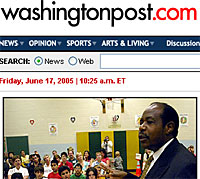 As traffic has increased traffic to news sites, newspaper editors have been allocating more content to their online editions, adding frequent news updates, weather news, original content, message boards and editorial blogs.
As traffic has increased traffic to news sites, newspaper editors have been allocating more content to their online editions, adding frequent news updates, weather news, original content, message boards and editorial blogs. In an interesting reversal of new media trends, online leisure retailer lastminute.com is to launch its first print magazine.
In an interesting reversal of new media trends, online leisure retailer lastminute.com is to launch its first print magazine.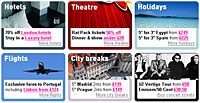 Not to be outdone, Brent Hoberman, chief executive of Lastminute.com, brewed up his own beefy brand of buzzword blather: “The launch of this magazine is a fantastic opportunity to engage with our most loyal customers and reinforce our brand values through inspirational and informative editorial.
Not to be outdone, Brent Hoberman, chief executive of Lastminute.com, brewed up his own beefy brand of buzzword blather: “The launch of this magazine is a fantastic opportunity to engage with our most loyal customers and reinforce our brand values through inspirational and informative editorial. America Online is taking on the likes of Yahoo, Hotmail and Google’s Gmail with its new free 2GB email service in the US, launched yesterday after trials earlier this year.
America Online is taking on the likes of Yahoo, Hotmail and Google’s Gmail with its new free 2GB email service in the US, launched yesterday after trials earlier this year. Users will be able to log in with their existing AOL IM screen name as their e-mail address, with an updated version of the AIM 5.9 software offering one-click access to AIM Mail.
Users will be able to log in with their existing AOL IM screen name as their e-mail address, with an updated version of the AIM 5.9 software offering one-click access to AIM Mail. The new free service represents a hefty shift in AOL’s business strategy which has traditional involved charging users subscription fees for its services. Instead, the company is expecting to generate revenue from AIM Mail through banner ads – hence the punter-tempting monster giveaway promotion.
The new free service represents a hefty shift in AOL’s business strategy which has traditional involved charging users subscription fees for its services. Instead, the company is expecting to generate revenue from AIM Mail through banner ads – hence the punter-tempting monster giveaway promotion. AOL has announced it will broadcast the Live 8 concerts in London, Philadelphia, Paris, Rome and Berlin online for free.
AOL has announced it will broadcast the Live 8 concerts in London, Philadelphia, Paris, Rome and Berlin online for free.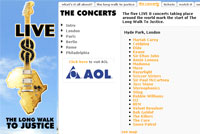 Geldof boomed: “The G8 leaders have it within their power to alter history. They will only have the will to do so if millions of people show them that enough is enough.”
Geldof boomed: “The G8 leaders have it within their power to alter history. They will only have the will to do so if millions of people show them that enough is enough.” The Training Foundation has launched its Ready for Work online training programme, an employment-awareness course free to all young people in (or recently in) full-time education and those in modern apprenticeships.
The Training Foundation has launched its Ready for Work online training programme, an employment-awareness course free to all young people in (or recently in) full-time education and those in modern apprenticeships. Each self study course ends with a short test to check the learner’s understanding, with an 80% or better grade qualifying the student for an optional Ready for Work Certificate and Ready for Work Handbook.
Each self study course ends with a short test to check the learner’s understanding, with an 80% or better grade qualifying the student for an optional Ready for Work Certificate and Ready for Work Handbook. David Frost, Director General of the British Chambers of Commerce roared his approval: “We need initiatives such as Ready for Work, which can help to ensure that young people leaving full-time education and training are equipped with skills that are both relevant for the workplace and will help advance their careers.”
David Frost, Director General of the British Chambers of Commerce roared his approval: “We need initiatives such as Ready for Work, which can help to ensure that young people leaving full-time education and training are equipped with skills that are both relevant for the workplace and will help advance their careers.”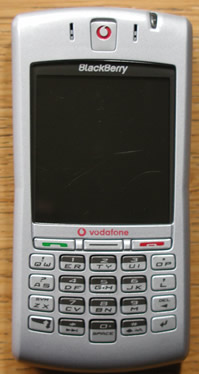 Following on from my recent detailed review of the Vodafone 7100v Blackberry, I thought it would be worth passing on a few tips I’d learnt over the process. One attempting to reassure readers through the scary process of upgrading the operating system on the 7100 Blackberry; the other, a solution for syncing your information with an Apple Mac – not something that is natively supported by RIM or Vodafone.
Following on from my recent detailed review of the Vodafone 7100v Blackberry, I thought it would be worth passing on a few tips I’d learnt over the process. One attempting to reassure readers through the scary process of upgrading the operating system on the 7100 Blackberry; the other, a solution for syncing your information with an Apple Mac – not something that is natively supported by RIM or Vodafone.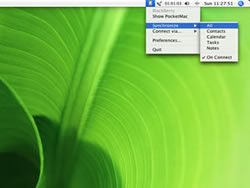 After updating the software, which by the way you need a Windows computer for, I set about syncing the Blackberry with my Mac. My existing phone, the Sony Ericsson P910i, works correctly out of the box with Mac OS X’s iSync application, syncing wirelessly over Bluetooth within a few seconds.
After updating the software, which by the way you need a Windows computer for, I set about syncing the Blackberry with my Mac. My existing phone, the Sony Ericsson P910i, works correctly out of the box with Mac OS X’s iSync application, syncing wirelessly over Bluetooth within a few seconds.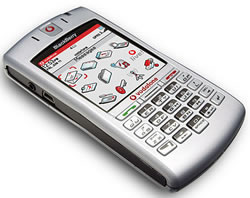 Part
Part 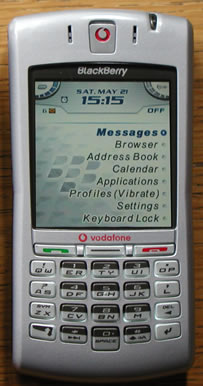 Screen
Screen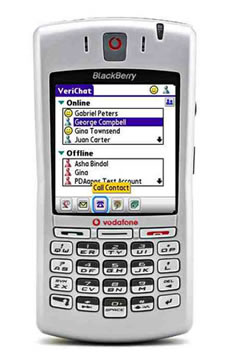 When Web pages are rendered, there are a lot of unnecessary images which would be represented instead by text. This text is usually shown in the ALT tags of the HTML from which the pages are rendered. On a lot of sites, there are a lot of navigation images, which are not good for render time on a low-powered device like the Blackberry: every time a page is opened containing images, these images are downloaded (this takes a long time with the Internet connection on a 7100v being at dial-up speeds). When downloaded these images are resized individually so as to fit on its screen.
When Web pages are rendered, there are a lot of unnecessary images which would be represented instead by text. This text is usually shown in the ALT tags of the HTML from which the pages are rendered. On a lot of sites, there are a lot of navigation images, which are not good for render time on a low-powered device like the Blackberry: every time a page is opened containing images, these images are downloaded (this takes a long time with the Internet connection on a 7100v being at dial-up speeds). When downloaded these images are resized individually so as to fit on its screen.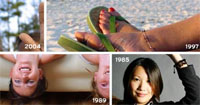 Time Warner is considering “spinning off” its AOL division to help finance acquisitions in the future, said chief executive Richard D. Parsons on Friday.
Time Warner is considering “spinning off” its AOL division to help finance acquisitions in the future, said chief executive Richard D. Parsons on Friday.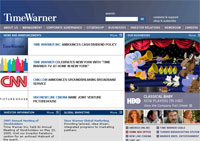 With Time Warner’s pockets already considerably lightened, transatlantic regulators then accused them of overstating advertising and subscriber numbers from mid-2000, with the company settling all charges with thumping great payments of US$510 million (~£279m ~€406.6m) in the States and US$300m (~£164~€239m) in the EU.
With Time Warner’s pockets already considerably lightened, transatlantic regulators then accused them of overstating advertising and subscriber numbers from mid-2000, with the company settling all charges with thumping great payments of US$510 million (~£279m ~€406.6m) in the States and US$300m (~£164~€239m) in the EU. AOL is now trying to find new revenue sources to compensate for the loss of U.S. subscribers to its dial-up Web access service, which has declined by 5 million users in three years, to 21.7 million.
AOL is now trying to find new revenue sources to compensate for the loss of U.S. subscribers to its dial-up Web access service, which has declined by 5 million users in three years, to 21.7 million. Despite the corporate wires buzzing with office gossips, chatting clerks, bored employees and downloading demons, a survey warns that IM remains unregulated in the workplace.
Despite the corporate wires buzzing with office gossips, chatting clerks, bored employees and downloading demons, a survey warns that IM remains unregulated in the workplace. Some 25% of particularly bored office workers have also used IM to download music and film trailers at work.
Some 25% of particularly bored office workers have also used IM to download music and film trailers at work. For example, anti-virus firm Symantec reported a 400 percent increase in IM and peer-to-peer (P2P) networking viruses, worms and trojans over the last 12 months.
For example, anti-virus firm Symantec reported a 400 percent increase in IM and peer-to-peer (P2P) networking viruses, worms and trojans over the last 12 months.